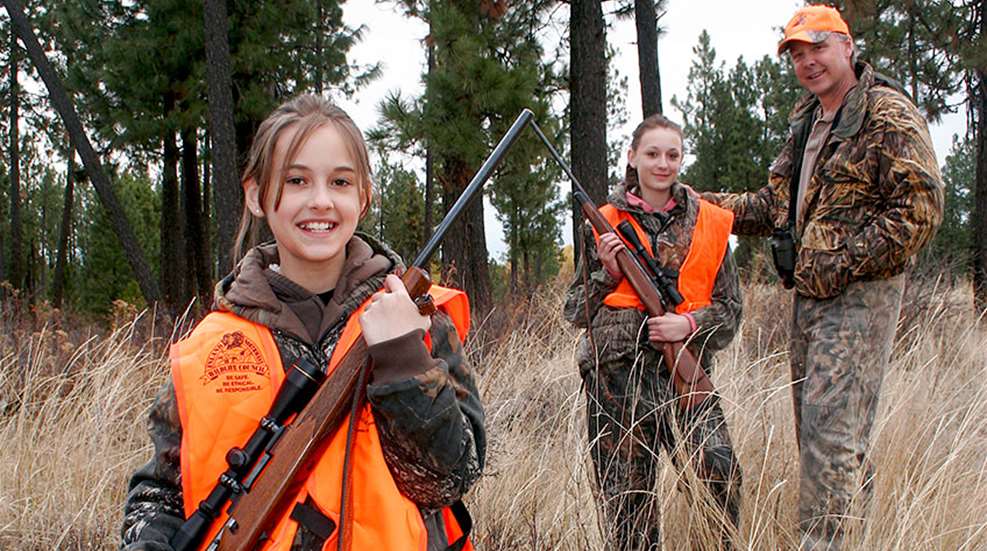
When Rhett Sandquist pulled the trigger of his borrowed Mossberg .243 Winchester, he didn’t flinch an inch. Neither did the buck he was shooting. The rifle went click and the whitetail just kept feeding. Rhett just lay there. Calm. Unperturbed. His first deer hunt was progressing perfectly.
“Where was the crosshair when the firing pin fell?” I whispered to my young charge.
“Right on his shoulder where I was aiming.”
“Perfect. That means you’d have gotten him if the chamber had been loaded. You want to load it?” Rhett nodded, so I handed him the magazine and told him to chamber a round. The two bucks we’d stalked never even looked up, probably because they were foraging 300 yards away.
“Now Rhett, keep your safety on and don’t shoot until I give you the go-ahead. But here’s the deal: The bullet is going to drop a bit because of the range, so what I want you to do is raise the crosshair so that the horizontal line is on top of the buck’s back. That way the bullet will drop into the heart. It’s just like that target you shot at yesterday. You aimed at the top. The bullet hit the bottom, right?”
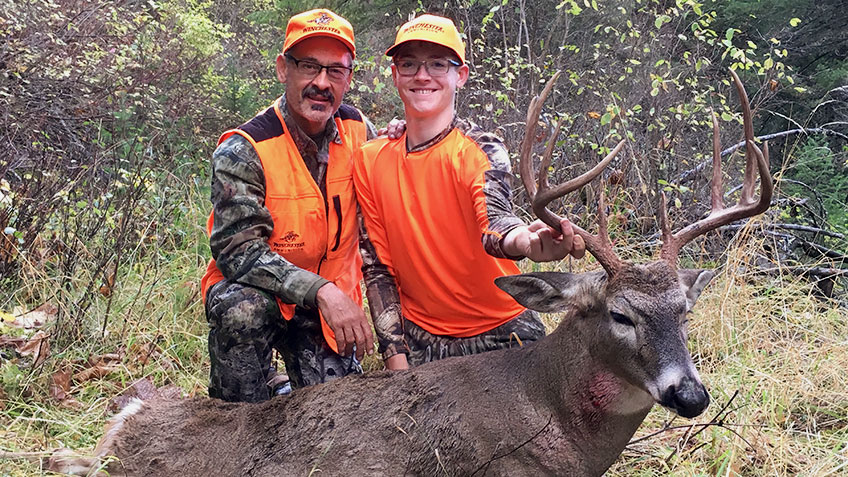
“Right.” The kid wasn’t even breathing fast.
“So keep the vertical crosshair on his shoulder, raise the horizontal until it’s level with his back. Got it?”
“Uh huh.”
“OK. When he’s broadside and you’re steady, you can shoot if you want to. No hurry. He isn’t going anywhere.”
Rhett lay unmoving behind the rifle, steady on the pack he’d pushed to the ridge. This time when he shot the buck did flinch. It ran a mad dash up the hill, tail twisting, and collapsed. Heart shot. From 320 yards.
Rhett was the youngest Sandquist I’ve had the pleasure of mentoring, but not the first. That dubious honor belongs to his grandpa Ken. Ken’s son and Rhett’s dad, Kevin, was No. 2 in the line. His older brother, Mitchell, was fourth. I gained more from each of them than they ever did from me. That’s why mentoring new shooters and hunters is so rewarding: everyone wins.
■ ■ ■
Mentoring is a hot topic these days. Everyone from state fish-and-game agencies to decoy manufacturers is lobbying for more mentoring because hunting participation is declining. We need more hunters, old hunters, women hunters and especially young hunters to carry the torch. You’d never guess this by how hard it is to draw a moose, sheep or elk tag, but that’s as much about shrinking habitat and increased predation as human hunters. The truth is the U.S. hunter population has dropped from 14 million in 1991 to 11.5 million in 2016. Only about 4.4 percent of U.S. adults hunt! While I like that for the empty fields it leaves for me and my hunting buddies, I hate it for its long-term impact on our rights to hunt and the survival of the wildlife we love.
Wildlife abundance hinges on hunter participation and financial support. Since the 19th century hunters have consistently been the user group that has sounded the alarm on declining wild habitats and wild species. We’ve also been the users coughing up the dollars to fund wildlife protection and restoration. Roughly 25 percent of state fish-and-game funding comes from license and tag sales, nearly 75 percent from excise taxes on guns, ammo, bows, arrows and similar hunting tools. A decline in hunters means a decline in wildlife. Once the baby boomers are gone, wildlife is going to be in a world of hurt.
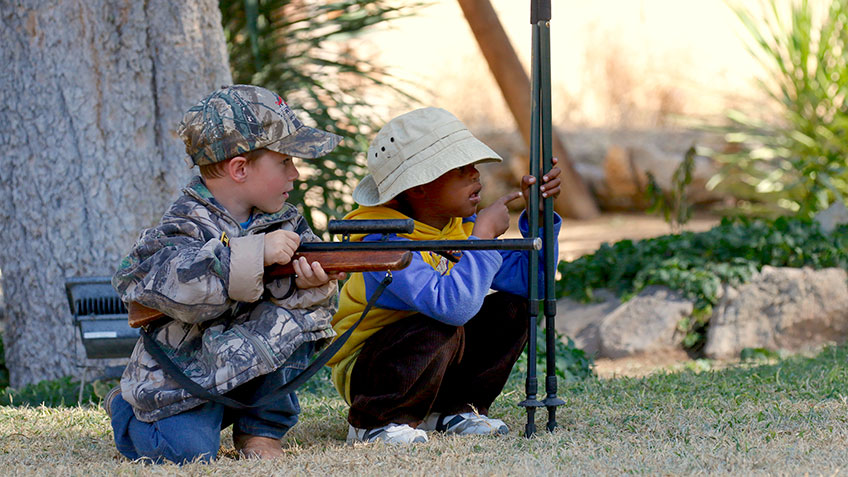
So be a mentor. A teacher. Just someone who shows another human his or her genetic potential to embrace the mystery, adventure, challenge, beauty and joy inherent in a personal, intimate interaction with the natural world. Hunting is our natural heritage. Humans evolved stereoscopic vision, hand-eye coordination, bipedal running, advanced communications, group coordination and advanced tool-making because we hunted. But these days, with nature fenced and manicured and put on display in tiny parks and “natural areas” surrounded by dozens of square miles of suburbia, young people no longer grow up in it. Instead of, “Here’s the rifle and two shells. Bring home two squirrels for dinner,” kids hear, “Shhh. Don’t disturb the squirrels. Oooh, aren’t they cute!”
It’s also tough for nature-in-the-raw to compete against video games and social media never farther away than a kid’s back pocket. Kids don’t grow up watching Davy Crocket and Daniel Boone. They don’t see fathers returning from Saturday bird hunts or November deer camps. They don’t listen to moms talk about how they went hunting with grandpa and how grandma had to shoot the badger in the chicken house. Hunting mentors are more critical now than ever.
■ ■ ■
But how do you start? First, by conducting your own hunting with respect, honesty, integrity and class. Do it right, don’t cut corners, and do it proudly. Know a thing or two about how hunters protect, defend and sustain wild creatures and wild places. This doesn’t mean shouting from the front porch or driving a dead buck through the neighborhood with the tailgate down and its tongue lolling out. But it could mean telling a simple story about how thrilled you were to have finally climbed to the top of Buck Mountain to sit in a hushed fall of snowflakes the size of quarters while a parade of steaming elk filed past, the rear brought up by this young raghorn. And how you were shaking so hard you didn’t think you could keep the crosshair on him, but when he stopped between two pines, you somehow settled the scope, squeezed the trigger and dropped him where he stood.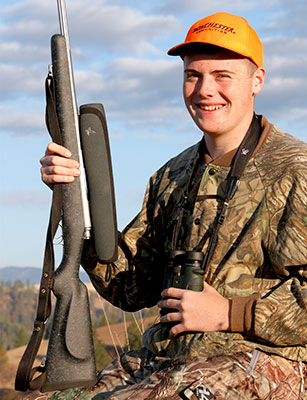
If you’re a lousy storyteller, just offer to take a potential hunter—of any age or sex—to the shooting range. Start them with safe gun handling and a .22. No recoil. Low noise. Inexpensive. Easy. Teach them good technique. Then let them plink big, easy-to-hit targets that react. Balloons. Plastic jugs of water. Swinging plates. Leave them hungry for more. As their interest increases, challenge them with longer distance, smaller targets, always emphasizing safe gun handling. And keep telling those stories of wild adventure, mystery and the big buck that got away.
Mentoring doesn’t mean kids only. Ken Sandquist, 20 years my senior, was surprised to learn there were turkeys on his rural property. I wove an elaborate tale of predawn gobblers, strutting, calling and luring. Ken used my pump 12-gauge and I did the calling. By the time Ken finally shot his gobbler he was as passionate about turkey hunting as he’d been crazy about girls in high school. And that enthusiasm spread to Kevin. The three of us spent many a spring morning rediscovering the wonders of their woods. Deer, elk, black bear, grouse, wildflowers, turkeys. Kevin and Ken finally roosted a bird by themselves, slipped under it the next morning, called it in and Kevin dropped it.
Family members are natural recruits to hunting, especially the boyfriends and girlfriends your kids and grandkids drag home. I took it quite slowly with my sons-in-law, letting them get used to the taxidermy in the office, sharing just a few tales from the Alaskan mountains and African plains. Brandon was easy because he’s a jerky junky. A bagful of elk jerky had him from the first bite. Alfredo, who enjoys cooking, fell in line with the first elk loin I gave him to grill. “Yeah, it’s free-range and grass-fed,” I promised him. “Antibiotic- and hormone-free, too.”
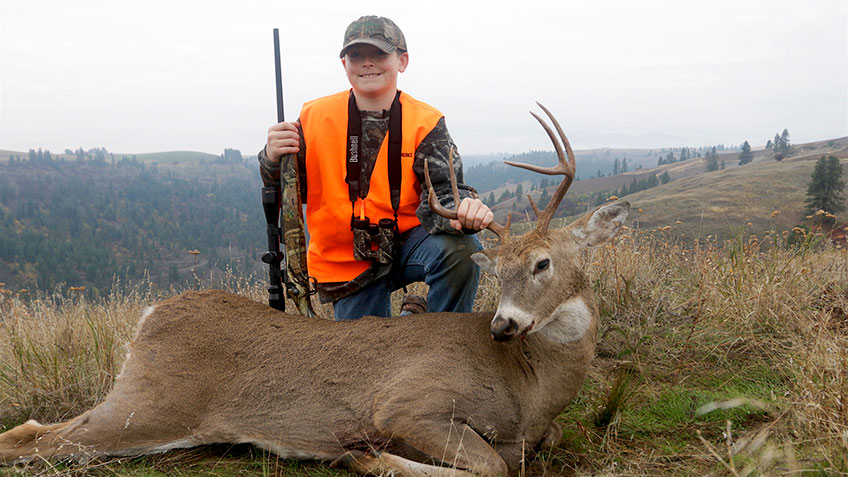
Eventually I gave the boys the good news. “Guys, I’m happy to keep you supplied while I can, but someday you’re going to have to get your own.” I gave each, one at a time, a tour of the gun room. Showed them some basic actions, the parts of a cartridge, let them dry-fire. “Yeah, we can go out shooting some time.” That didn’t happen until they’d asked about it a couple more times. When they showed enough interest, Santa dropped rifles down their chimneys, and now we’re applying for deer tags.
Sibling rivalry can help drive hunting enthusiasm. Rhett’s year-older brother, Mitchell, was pretty keen to get a deer of his own after Rhett showed up with his. Mitchell didn’t get one that year, so he was first up the next season. His buck required a quick race down a steep canyon, then a slow crawl over a rise. Just like Rhett, prone over the pack. This time the rifle was a .270 Winchester and the buck was 284 yards out. “Take your time. Put the crosshair right in the middle of his shoulder … ”
Click! If the deer allow, I always make the kids dry-fire while I watch to see if they’re flinching. It prevents wounding loss and a bad experience for everyone. Mitch was almost as calm and steady as Rhett had been. So I gave him the go-ahead for a live round, and when the buck stood broadside, I became the proud mentor of my fourth Sandquist family game harvest.
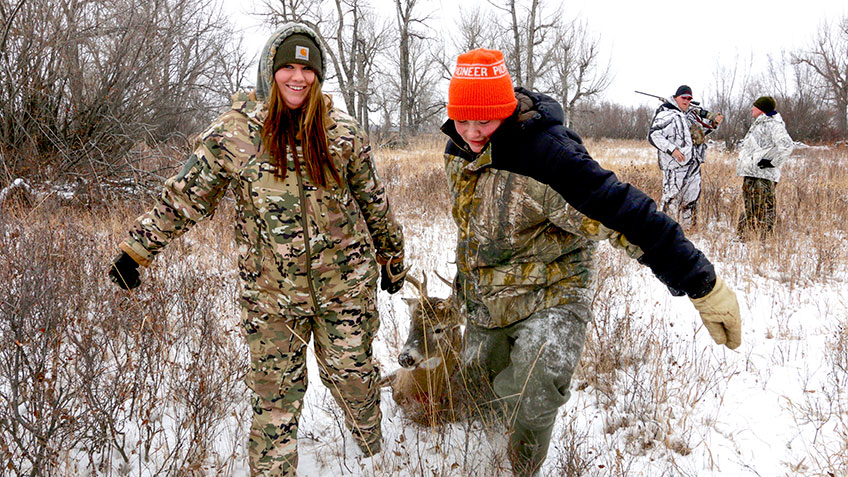
Sometimes you should mentor a mentor for someone who needs a mentor. Like my wife. Whatever it is that makes some men less patient with their wives than with anyone else, I have it. So when my bride showed interest in hunting, I subcontracted the job to our then African PH, Hannes. Took the stress off me and Elizabeth. As a result, she made a perfect, one-shot kill on a springbok. She’s gone on to duplicate that feat with mule deer, whitetails, sable, wildebeest, kudu, oryx and much more. I now have a bride who jumps at the chance to go hunting with me. Best mentoring job I’ve ever done.
As you teach, try to mix it up and make it fun. I have a tendency to dive too deep into the how and why, overdoing the mechanics of firearms and optics. Watch your students and if they start to get a glazed look, back off. By all means instruct them on the essentials, especially safe gun handling, but don’t force feed them calibers, boattails, triple locking lugs, wind deflection and spin drift. Play to their interests, not yours. Some are immediately interested in all aspects of the rifle. Others are all about the wilds, the animals, the adventure. So point out the tracks of a coyote vs. bobcat. Show where the bear rubbed his back against the tree and left those black hairs. Call in that screech owl. Set up a spotting scope and let your protégé watch a couple of young bucks spar on the far hillside. Go along on a stalk, even if you don’t intend to hunt, just to give them the thrill of getting close. Show them the fun, the mystery, discovery and achievement. That’s what they need.
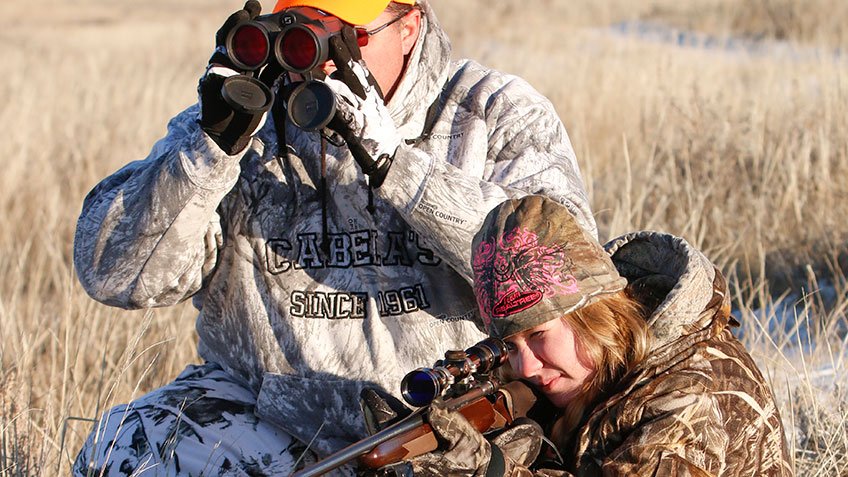
Finally, make a big deal about their accomplishments regardless how small. “It was colder than the inside of a frozen turkey out there, but Jennifer didn’t complain a bit! She’s one tough soldier. Zach sat so still I think a deer would have eaten lettuce out of his hands!” Whether they tag a bull or bunny, it’s a trophy. Make some pictures. Frame one and present it later. Take special care of the meat, hide and antlers so your new hunter can share the harvest. It’s a confidence booster for anyone to discover they are capable of getting their own food from nature. Suddenly they are more than a spectator. They are a participant. Like the coyote and lion, the eagle and wolf, they are playing their natural role in that ancient cycle of life. They are hunters. And you are a hero.
John Annoni and Camp Compass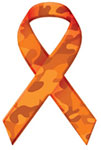 Middle-school science teacher John Annoni may be the most dedicated, successful hunting mentor I know. Each year for two decades Annoni has instructed some 60 students, mostly inner-city kids, in his after-school Camp Compass Academy (“First Light,” May 2013). Students learn about conservation, hunting, fishing, shooting, self-respect and responsibility. And it doesn’t stop with classroom study. Annoni takes many of them hunting and fishing, watching their self-confidence grow as they discover they have the skills to put food on the table.
Middle-school science teacher John Annoni may be the most dedicated, successful hunting mentor I know. Each year for two decades Annoni has instructed some 60 students, mostly inner-city kids, in his after-school Camp Compass Academy (“First Light,” May 2013). Students learn about conservation, hunting, fishing, shooting, self-respect and responsibility. And it doesn’t stop with classroom study. Annoni takes many of them hunting and fishing, watching their self-confidence grow as they discover they have the skills to put food on the table.
Annoni has introduced more than 1,000 urban kids to the benefits of managed sport hunting, making him a master mentor.
To fund Camp Compass, unite hunters and help educate the public about critical roles hunters play in conservation, Annoni initiated a ribbon campaign. He sells camouflaged orange ribbons emblazoned with “Hunting Awareness” to increase the profile of hunters and hunting. Hunting clubs and organizations can sell the ribbons to fund their programs and spread the good news about hunters and conservation. Visit huntingawareness.com to learn more.




































